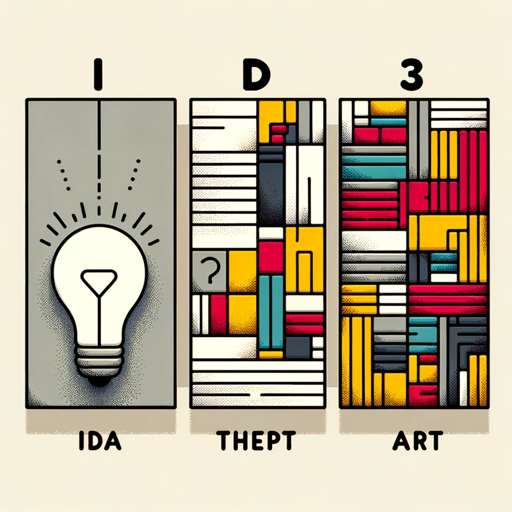Prompt Engineering-AI-powered prompt engineering tool.
Optimize AI interactions with precision.
Your go-to assistant for optimizing ChatGPT prompts, specializing in LLMs and generative AI. Enhances prompt clarity, specificity, and effectiveness. Adapts to any language, ensuring smooth interaction. Aims for well-structured prompts to maximize languag
Can you review the prompt below according to the principles and best practices in prompt engineering?
I have an idea for a prompt but I'm not sure how to start. Can you help me develop it from scratch? Ask me questions until you have enough information to create the prompt based on the best practices of prompt engineering.
Rate this prompt bellow:
/help
I'm interested in understanding more about prompt patterns. Could you explain what prompt patterns are and discuss the key patterns that can enhance the effectiveness of AI responses?
I'm new to prompt engineering. Could you explain and show me the six principles and 16 best practices of effective prompt design?
I'd like to learn about key concepts in LLM and Generative AI.
Please provide examples of good ChatGPT prompts by OpenAi
Could you explain prompt patterns and share all the types you're familiar with?
In what ways can I refine my prompts to reduce AI hallucinations?
Could you suggest prompt patterns to improve my prompt bellow?
Could you teach me about the Persona Pattern: in prompt engineering and how it affects AI responses?
Related Tools

Prompt Engineer
Generate superior ChatGPT prompts or improve your existing prompts. Become a pro prompt engineer, by learning and applying best prompt practices.

Prompt Bug Buster
🔵 Detect bugs 🐞 in your prompts, enhance them to create sophisticated, optimized Meta Prompts for generative AI🔵

Engineering
Expert in engineering knowledge

PromptGPT
AI assistant for refining user prompts to maximize GPT-4 interaction. New updated instructions !! [sponsored actions]

Auto Prompt Agent 🚩
Prompt Engineer automatically enhances the prompt, autonomously reasons based on that prompt, and generates exceptional responses.

Advanced Meta-Prompt Engineering
Cutting-edge prompt engineering tool designed for advanced meta-prompt synthesis and refinement. Please reference Nerority Github page for instructions. This is for the synthesis of complex system prompts. Begin the workflow with !start [prompt]
20.0 / 5 (200 votes)
Introduction to Prompt Engineering
Prompt Engineering involves crafting inputs (prompts) for Generative AI models like GPT-4 to achieve desired outputs. It is essential in maximizing the model's effectiveness by providing clear, detailed, and context-rich prompts. Prompt Engineering helps guide the AI's responses, ensuring relevance and accuracy. For instance, when instructing the model to generate a specific style of writing or a particular type of output, a well-crafted prompt can make a significant difference. Examples include using structured prompts for generating program code or detailed descriptions for creative writing tasks.

Main Functions of Prompt Engineering
Precision and Simplicity
Example
Simplifying complex language into more understandable terms.
Scenario
An educational platform uses precise and simple prompts to convert complex academic texts into summaries that second-grade students can understand, enhancing their learning experience.
Output Customization
Example
Tailoring AI responses to specific formats or templates.
Scenario
A business utilizes customized prompts to generate standardized emails for customer support, ensuring consistency in communication.
Prompt Improvement
Example
Refining user queries for better accuracy.
Scenario
A research assistant tool suggests refined questions to researchers, leading to more precise information retrieval and analysis.
Ideal Users of Prompt Engineering Services
Educators
Teachers and educational content creators can use prompt engineering to develop tailored educational materials, simplifying complex subjects for students of various levels.
Business Professionals
Marketers, customer service teams, and content creators benefit from using prompt engineering to generate customized, consistent, and high-quality communication, enhancing engagement and productivity.

Guidelines for Using Prompt Engineering
Step 1: Visit aichatonline.org for a free trial
Visit aichatonline.org to access a free trial without needing to log in or subscribe to ChatGPT Plus. This will allow you to test the platform's prompt engineering tools directly.
Step 2: Understand the Basics of AI Interaction
Familiarize yourself with how generative AI models like GPT-4 work. This includes understanding tokens, context windows, and the probabilistic nature of outputs.
Step 3: Start with Simple Prompts
Begin by crafting straightforward prompts to see how the model responds. Experiment with different prompt structures to learn what works best for your use case.
Step 4: Iterate and Refine
Use trial and error to refine your prompts. Pay attention to the specificity, clarity, and context of your prompts to achieve more accurate and relevant responses.
Step 5: Leverage Advanced Prompt Patterns
Explore advanced prompt patterns, such as the 'Cognitive Verifier' or 'Template Pattern', to enhance the effectiveness of your prompts for complex tasks.
Try other advanced and practical GPTs
MidJourney Prompt Generator
AI-driven descriptions for your creative needs.

Midjourney Prompt Generator Pro
Transform ideas into AI-driven visuals.

MJプロンプトメーカー
Optimize your Midjourney images with AI-crafted prompts.

Midjourney Prompter
AI-Powered Prompts for Creative Imagery

MidJ prompter v6
AI-powered prompts for creative visualizations

MidJ Prompt Generator for V6
Craft Perfect Prompts for MidJourney

Game hub GPT
Unleash the Power of AI Gaming

Prompt
AI-Powered Solutions for Every Task
Video Editor
AI-powered video editing made easy
公众号爆文AI
Create Viral Content with AI Precision

公众号篇篇10w+
AI-powered text optimization and rewriting

代码助手
AI-powered coding assistance for everyone

- Content Creation
- Data Analysis
- Automation
- SEO
- Programming
Prompt Engineering Q&A
What is prompt engineering?
Prompt engineering is the process of crafting and refining prompts to guide generative AI models like GPT-4 in producing specific, relevant, and high-quality responses. It involves understanding how the model interprets language and using that knowledge to create effective prompts.
Why is prompt engineering important?
Prompt engineering is crucial because it directly influences the quality and relevance of the AI's output. Well-engineered prompts can lead to more accurate, creative, and useful responses, making the AI a more effective tool for various applications.
What are some common use cases for prompt engineering?
Common use cases include automating content generation, enhancing customer support through chatbots, creating educational tools, and even assisting in software development by generating code snippets or debugging existing code.
How can I improve the outputs of a generative AI model?
To improve outputs, focus on crafting clear, specific prompts that include relevant context. Iteratively refine your prompts based on the responses you receive, and consider using advanced prompt patterns like the 'Persona Pattern' or 'Reflection Pattern' to tailor the AI's behavior.
What are the prerequisites for effective prompt engineering?
Effective prompt engineering requires a basic understanding of how AI models process and generate language, familiarity with the specific model you are using (e.g., GPT-4), and a willingness to experiment with different prompt structures to achieve the desired outcomes.